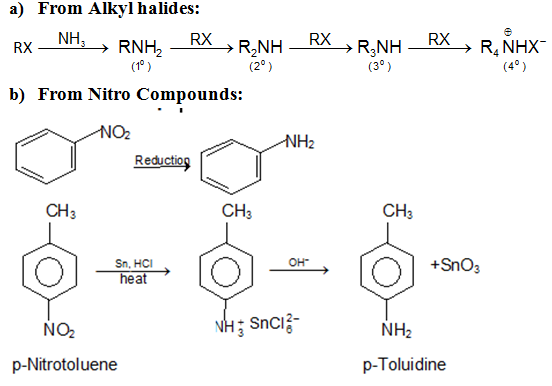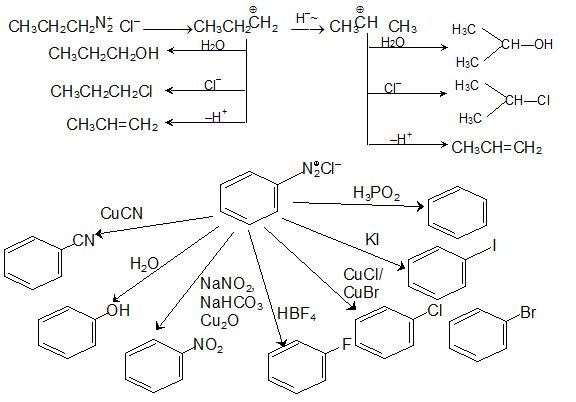Amines
Structure of amines: Trigonal PyramidalBasicity of Amines
a) Aliphatic Amine:Basic Strength: NH3 < RNH2 < R2NH < R3N,b) Aromatic Amine:Basic Strength: NH3 > Ar- NH2 > Ar2- NH2Benzene ring decreases the electron density over N atom due to resonance effect.Preparation of Amines


Chemical Reactions
a) Acylation:RNH2 + R'COCl→ R'CO NHR an N-substituted amideR2NH + R'COCl → R'CO.NR2 an N,N disubstituted amideb) Benzoylation (Schotten Baumann Reaction)Primary amine reacts with benzoyl chloride to give the acylated productc) Carbylamine Reaction (Given Only by Primary Amines):C2H5NH2 + CHCl3 + 3KOH → C2H5NC + 3KCl + 3H2OC6H5 NH2 + CHCl3 + 3KOH → C6H5NC + 3KCl + 3H2Od) Action with Aldehyde and Ketone:e) Hofmann Mustard Oil Reaction:f) Reaction with Carbonyl Chloride: C2H5 – NH2 + COCl2 → C2H5NCO + 2HClg) Hofmann Elimination: When a quaternary ammonium hydroxide is heated strongly (125° or higher) it decomposes to yield water, a tertiary amine and an alkeneh) The diazonium salts of amines: i) Reaction of Tertiary amines with Nitrous acid:When a tertiary aliphatic amine is mixed with nitrous acid, an equilibrium is established among the tertiary amine, its salt, and an N-Nitrosoammonium compound.j) Coupling Reactions of Arene Diazonium Salts:k) Ring Substitution in Aromatic Amines:l) Aniline -X rearrangement:
i) Reaction of Tertiary amines with Nitrous acid:When a tertiary aliphatic amine is mixed with nitrous acid, an equilibrium is established among the tertiary amine, its salt, and an N-Nitrosoammonium compound.j) Coupling Reactions of Arene Diazonium Salts:k) Ring Substitution in Aromatic Amines:l) Aniline -X rearrangement:Such compounds are not much stable so the group X migrates mainly at p-position.
1. Fisher-Hepp rearrangement2. Phenylhydroxylamine - p-aminophenol rearrangement.Separation of a Mixture of Amines:
a) Hinsberg’s MethodPrimary amine: RNH2 + C6H5SO2Cl ¾® C6H5– SO2 – NH – R + HClC6H5– SO2 – NH – R : N-alkyl benzene sulfonamidesDissolves in NaOH due to acidic H-attached to Nitrogen)Secondary amineTertiary amine : Tertiary amines do not react with Hinsberg’s reagent.a) Hofmann’s Method:The mixture of amines is treated with diethyloxalate, which forms a solid oxamide with primary amine, a liquid oxime ester with secondary amine. The tertiary amine does not react.Test for Amines
Primary amine is treated with a strong base in presence in chloroform, an isocyanide is formed and this isocyanide thus formed has a very foul smell.Secondary amine is converted into nitrosoamine by treating the amine with nitrous acid. The resultant solutions warmed with phenol and concentrated H2SO4, a brown or red colour is formed at first soon it changes to blue and then to green. The colour changes to red on dilution and further changes to greenish blue on treating with alkali.Tertiary arylamines react with nitrous acid to form o-nitroso aromatic compound
Sunday, May 27, 2018
Subscribe to:
Post Comments (Atom)














0 comments:
Post a Comment